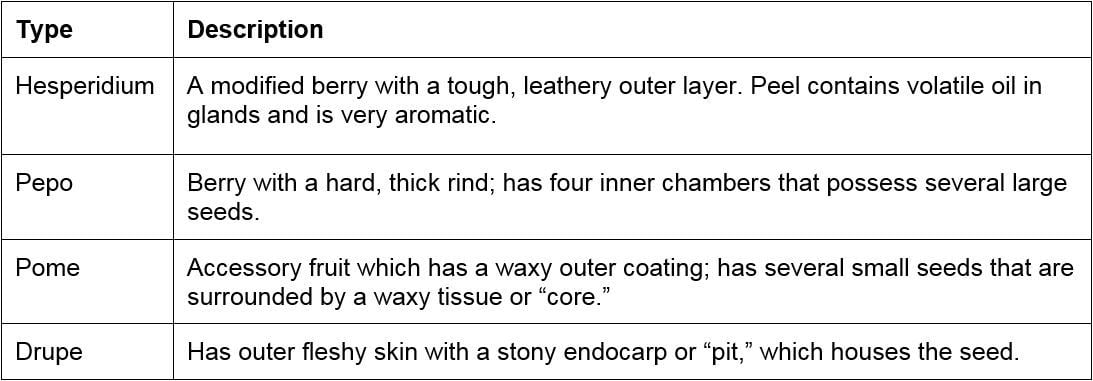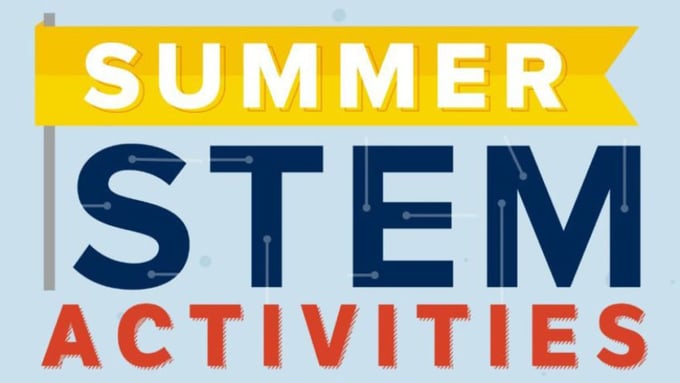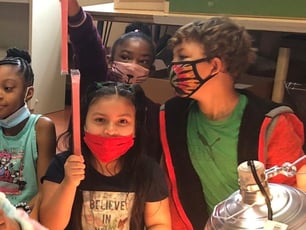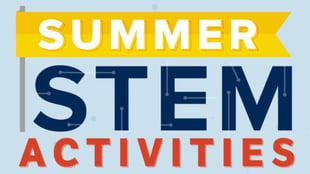To help stave off summer learning loss and keep students' STEM skills sharp over the summer, Project Lead The Way has compiled a list of 15 simple (and FUN!) STEM activities families can do at home over break.
Special thanks to the following 2017 PLTW Teachers of the Year for their contributions to this piece!
- Nimmi Arunachalam | PLTW Computer Science Teacher of the Year | Olympic Heights Community High School | Boca Raton, Florida
- Sandy Bradshaw | PLTW Launch Teacher of the Year | Midway Elementary School | Anderson, South Carolina
- Frank Decker | PLTW Engineering Teacher of the Year | North Lawrence Career Center | Bedford, Indiana
- Kelly Garcia | PLTW Gateway Teacher of the Year | Norwalk-La Mirada Unified School District | Norwalk, California
- Michael Lindley | PLTW Biomedical Science Teacher of the Year | Wes Watkins Technology Center | Wetumka, Oklahoma
Check out the 15 super-cool STEM activities below:
1. Build Interactive E-Textiles
LilyPad Sewable Electronics meld creativity and engineering through a variety of e-textile projects that provide a fun visualization of STEM concepts for all ages. Projects combine concepts of electronics, fashion, hardware, and computer science.
2. Rocket Into Outer Space
If you own a joystick and love space exploration, use the Orbiter 2010 space shuttle simulator program to simulate flying the space shuttle Atlantis, launching from the Kennedy Space Center (KSC) in Florida, docking with the International Space Station, and landing on one of the runways at KSC. This space simulator game incorporates laws of physics in order to give players a realistic space experience.
3. Construct a Mousetrap Car
Make a mousetrap move – without the aid of a mouse! – with this highly popular engineering project: the mousetrap car. Use the potential energy in the spring of the mousetrap to power a car across the floor. Caution: The spring mechanism is a safety hazard and may require adult supervision.
4. Engage in Physical Computing
The BBC micro:bit can be used for all sorts of cool physical computing projects. Students can learn to code using a block programming language or a text-based program such as Python; all software is web-based, so no software downloads are required. One of the coolest elements of this activity: The LED lights on the micro:bit react to programmed instructions and can literally make a robot dance to music! Happy coding!
5. Become a Disease Detective
Play the game “Solve the Outbreak” to learn how epidemiologists track down the cause of pathogens and stop their spread. Using case studies, clues, and critical-thinking skills, you can earn badges as you find solutions to protect the public – just like investigators at the Centers for Disease Control!
6. Explore Your Backyard Ecosystem
Plant a butterfly garden, start a worm farm, or hang a bird feeder to learn more about your local wildlife. Keep a journal to document your observations with sketches, photos, and questions.
7. Build Structures With Straws
When it comes to straws and STEM, the only limit is your imagination! Young learners can use tape and straws to build tall towers, bridges, rafts, and more. While normal drinking straws work just fine, Skoolzy Straw Sets are very durable and can be used more than once.
8. Fashion a Lava Lamp From Scratch
Creating your own lava lamp is a fun, low-cost activity for young scientists! You can do this activity using supplies commonly found around this house, such as a glass, vegetable oil, food coloring, and Alka-Seltzer (to make your lamp fizz!). Check out this tutorial for more information.
9. Sail the High Seas in a Cardboard Boat
Test your engineering skills by building a boat out of only cardboard and duct tape! Potential sites to host a cardboard-boat competition include your high school’s pool, a public community pool, or a lake.
10. Make a Structure Out of Hula Hoops
This is a great STEM activity that promotes teamwork. Provide a group of elementary-age students with six hula hoops, and challenge them to build a structure that will allow them to sit inside.
11. Become a Fruit Sleuth
Enjoy this healthy botany lab for students of all ages!
Materials:
- Apple
- Cucumber
- Peach
- Orange
- Pear
- Lemon
- Cantaloupe
- Cherries
Directions:
Using the criteria listed below, try to match each fruit with another from the same fruit class. Caution: Cutting fruit is a safety hazard and may require adult supervision.

Answer Key:
- Hesperidium: lemons, oranges
- Pepo: cantaloupe, cucumber
- Pome: apple, pear
- Drupe: cherry, peach
12. Make a Splash With STEM
Start with a pool noodle, and the STEM possibilities are endless! Children can follow the Engineering Design Process to build a marble run or a simple structure from pool noodles.
13. Create an Interactive Art Display
Let your creativity flow by building an electronic circuit on paper! One fun approach is using aluminum foil and old Christmas lights, along with a watch battery, for circuit designs that sparkle and shine. The best part? Paper circuits can be placed anywhere, so when it comes to the projects you can create, the sky is the limit!
14. Create With Cardboard
Makedo Cardboard Construction Kits provide plastic connector pieces and tools that allow children (and adults) to use cardboard to create almost anything!
15. Add These STEM Books to Your Summer Reading List
Great reads for young learners include “Rosie Revere, Engineer” and “Iggy Peck, Architect” by Andrea Beaty and “The Most Magnificent Thing” by Ashley Spires.


